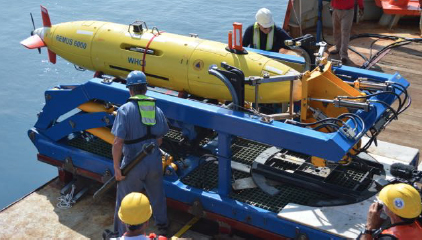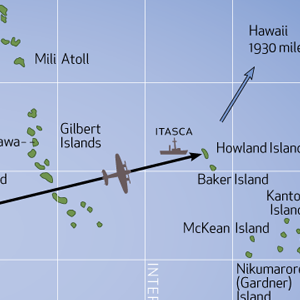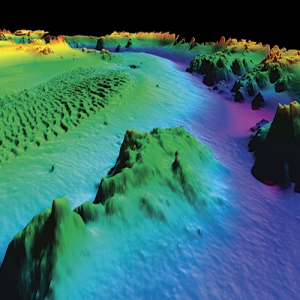Central Pacific Edition
REMUS 6000
WHOI’s Autonomous Deep Water Search System

The Woods Hole Oceanographic Institution (WHOI) REMUS 6000 Autonomous Underwater Vehicle (AUV) represents the latest in advanced deep water search technology. Unlike a towed sonar or an ROV which are tethered to a surface vessel by a long and massive cable, AUVs swim freely and can operate with great efficiency. REMUS can dive to a depth of 6,000 meters (nearly 20,000 feet) and can stay down nearly a full day before it must return to the surface for fresh batteries.
Before a dive, called a sortie, the vehicle is given a mission plan by its operators specifying a search pattern and what sensors to use. Once in the water, REMUS is on its own and must navigate, follow terrain, and avoid obstacles autonomously. If something goes wrong, it must sense the problem and take action to return safely to the surface without human intervention.
The system has proven to be highly reliable. Greg Packard, lead engineer for our Amelia Earhart search expedition, says the REMUS on our expedition has performed 223 successful dives since it was launched.
The AUV can carry a number of sensors, principle of which are a sidescan sonar that can image a wide swath of seafloor with acoustic pulses, and an electronic still camera with strobe lighting. Its sophisticated navigation system includes an inertial system that senses accelerations and an acoustic Doppler sonar that senses velocity. For precision navigation, the system operates within a network of acoustic beacons that act like an underwater GPS. Also, REMUS can communicate with the surface ship to provide tracking and status reports. Unfortunately, it is impossible to send a lot of information over acoustic links, so the operators must wait until the vehicle returns to the surface and is recovered aboard to download sonar and optical imagery for analysis.
Greg is supported by engineers Neil McPhee, Mark Dennet, and Christopher Griner who must wrangle the 12-foot long one-ton torpedo shaped vehicle out of the water using an articulated launch and recovery frame. Once on board, the system is winched into a container van where the team immediately begins preparing it for the next dive. Sonar data is downloaded; the camera is swapped with the spare (so images can be downloaded in the lab); the batteries are swapped for a freshly charged set; and a new mission sortie plan is uploaded into the vehicle’s memory. Within two hours, the system is ready to be launched on another dive to the deep.



